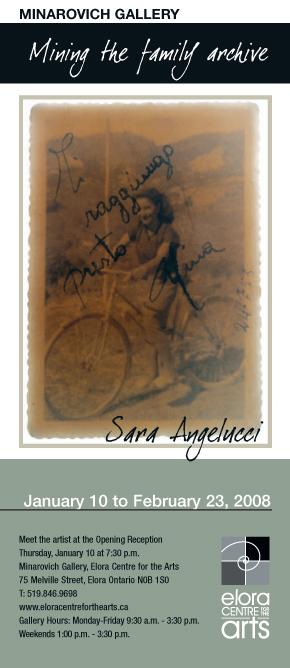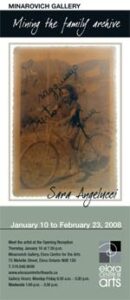Sara Angelucci: Mining the Family Archive
Artist Statement
Mining the Family Archive
www.sara-angelucci.ca
January 10 to February 23
 This exhibition brings together a number of projects created over a ten-year period (1997-2007) inspired by images and most recently stories derived from my family archive.
This exhibition brings together a number of projects created over a ten-year period (1997-2007) inspired by images and most recently stories derived from my family archive.
In the earliest work, a video installation entitled Questions She’ll Never Answer, I begin a dialogue with a photograph of my mother taken ship-board while immigrating to Canada—trying to unravel its stubbornly held mysteries. Questions ranging from “What colour was your dress?” to “What were your hopes for your new life?” attempt to reconcile the loss of my mother, and with it a connection to my ancestral history. The work points out that while old photographs can tell us some things—the name of the ship was the Conte Biancamano, they more often than not conceal more than they reveal.
In the triptych She Crossed the Sea, the sense of searching for information is accentuated as the same ship-board photo is held up against the sky, a virtual sea of blue, and turned to show the writing on the back. In its softness of focus, my mother’s image appears talismanic. The text, written in Italian in my mother’s hand reads: “Aboard this grand piazza, I turn my thoughts to you. Yours always, Nina.”
This notion of flipping between image and text is developed further in the series Al Riverso (in reverse). The source photographs for this series go back to my family’s pre-immigration period, Italy in the early 50’s. These photographs were selected because they contain writing on the back that provides the image with some contextual information; the character of the handwriting, a short salutation, name, date, or photo studio stamp.
In the process of examining image and text, I was reminded of a statement by Roland Barthes, “memory is like a transparent envelope.” Inspired by this idea, I held the image to the light, placing it text side up on a light box and found that while the text was clearly legible, the image bled through the paper, out of focus but merging with the text. In re-photographing the merged image and text I created a hybrid image that attempts to reconcile all the clues the photograph provides.
What often accompany images are stories, the oral histories that go along with photographs form the backbone of family history. In Double Take I stage the retelling of a true story, a traumatic event that became a marker in our lives. In recounting family memories, our stories were often framed in the context of before this event occurred (the death of a loved one) and after.
Such personal traumas as the loss of a loved one are common occurrences. Like all of the works in this exhibition, Double Take seeks to remove the personal components of the story. We do not know the names of the sisters or whose death they describe. In distancing these works from such details, the exhibition points to a denominator we all share; a recognition that photographs have the power to construct memory, developing a history and mythology of the family.
Sociologist Pierre Bourdieu wrote a seminal book on the role photography in the life of the family. As Bourdieu points out, it is part of the ritual of family life to record special festivities or holidays. He adds that there is a direct correlation between the presence of a camera in the household and the presence of children. The camera plays a key role in “solemnizing and immortalizing the high points of family life.”
Throughout this exhibition, there is an unspoken reverence for the small, precious black and white photographs of another era. The works in Mining The Family Archive celebrate the beauty of their formal qualities—the sense of occasion that accompanied their making, the quality of printing, and the physical tangibility of the image. In our digital age, hard-drives have replaced the photo album as the keepers of memory. While we may now store thousands of images, how many of them will ever be seen, and how long will a pixel last? Even with technological advancements, images seem to find a way to escape our grasp.
Biography of Sara Angelucci
Sara Angelucci is a photo and video artist living in Toronto. She completed her B.A. at the University of Guelph and her M.F.A. at the Nova Scotia College of Art and Design. She has exhibited her photography across Canada including exhibitions at Le Mois de la Photo in Montreal, Ace Art in Winnipeg, Vu in Quebec City, the Toronto Photographer’s Workshop, the MacLaren Art Centre, the Art Gallery of Hamilton and the Richmond Art Gallery.
Her videos have been screened across Canada and included in festivals in Europe and Hong Kong. Sara has participated in artist residencies at NSCAD (Halifax), the Banff Centre and at Biz-Art in Shanghai, China.
Sara’s work is represented by the Wynick/Tuck Gallery and V-Tape in Toronto.
